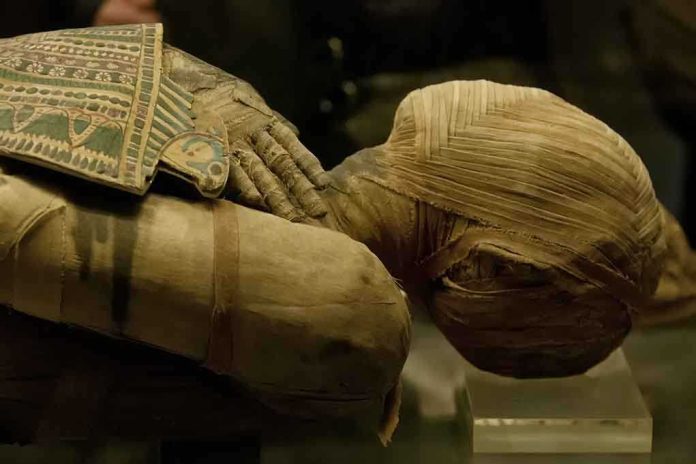
One wrong tremor or another season of Egyptian rains, and Tutankhamun’s tomb—the world’s most revered archaeological vault—could be lost forever, leaving us with only questions about what else lies buried with the Boy King’s legacy.
Story Snapshot
- Tutankhamun’s tomb faces its highest risk of collapse since its 1922 discovery.
- Major ceiling fractures and water infiltration are accelerating decay.
- Experts warn of imminent heritage loss unless urgent intervention occurs.
- Bureaucratic inertia threatens to outpace scientific preservation efforts.
Centuries in the Making, Minutes from Disaster
One hundred years after Howard Carter’s lantern first flickered against the golden death mask of Tutankhamun, the tomb now teeters on the edge of irreversible collapse. Structural fractures, especially a major fissure slicing through the ceiling, have left the walls and roof in their most fragile state since their ancient builders sealed them. Water from the catastrophic 1994 flood seeped deep into the porous Esna shale, fostering fungal blooms and loosening pigments that once dazzled the West. Despite decades of warnings, today’s risk is unprecedented and accelerating by the day.
Repeated calls for action echo through Cairo’s academic halls and the chambers of the Ministry of Antiquities. The tomb’s unique vulnerability—small size, weak geological foundation, and exposure to unpredictable flash floods—makes it a scientific case study in how ancient marvels can become modern crises. The tomb’s popularity as a tourist magnet only intensifies the threat, with humidity levels and micro-vibrations from footsteps compounding the fragile ceiling’s woes. Researchers tracking micro-cracks and pigment loss argue that the next collapse could take with it irreplaceable wall paintings, ending a chapter in world history.
The Bureaucratic Bottleneck: Science Meets Inertia
Decision-making over the tomb’s fate sits squarely with Egypt’s Ministry of Antiquities, whose slow or reactive approach stands in sharp contrast to the urgency voiced by academic experts. Professors like Sayed Hemeda and Mohamed Atia Hawash from Cairo University have issued stark warnings about the tomb’s geological instability, calling for immediate humidity control, structural reinforcements, and the formation of a high-level crisis committee. Yet, preservation plans remain stalled by bureaucratic procedures and competing interests, a pattern all too familiar in heritage sectors where political pressures often override scientific consensus.
The Egyptian Archaeologists’ Union, led by figures such as Emad Mahdi, now advocates for a dedicated risk-monitoring body—a move that would shift authority from slow-moving administrators to technical specialists. The stakes are enormous: without intervention, not only could Tutankhamun’s tomb collapse, but Egypt could suffer a blow to tourism revenues, national pride, and its standing as a steward of human heritage. The crisis is now so acute that it has prompted renewed international scrutiny, with UNESCO and global researchers watching for signs of either progress or irreversible loss.
Tutankhamun’s tomb at risk of collapse in most fragile state since its discovery 100 years ago
https://t.co/coUBsje4U8— Paul Quibell-smith 🔶 (@QuibellPaul) October 18, 2025
The Ripple Effect: Global Heritage in the Balance
Other tombs in the Valley of the Kings have suffered similar fates, but none have matched the cultural or symbolic weight of KV62. The 1994 flood should have served as a wake-up call, but the intervening decades have brought only incremental monitoring—never the comprehensive, preventive action experts demand. The immediate risk to the tomb’s integrity is matched by broader questions: How many more sites in Egypt and worldwide sit on the brink of disaster, their preservation hostage to bureaucratic delay?
Short-term, the loss would devastate Egypt’s scientific and tourism sectors, with ripple effects on local communities and the nation’s global reputation. Long-term, the collapse would mark a watershed moment for heritage management, forcing a reckoning with how nations protect—or fail to protect—their most precious treasures. For the international community, the lesson is clear: ancient wonders demand modern vigilance, not just reverence.
Expert Testimony: The Last Line of Defense
Leading authorities agree—this is the gravest threat Tutankhamun’s tomb has faced since Carter broke the seal in 1922. Structural engineers, geologists, and archaeologists have all pointed to the same culprit: a convergence of geological frailty, environmental assault, and administrative inertia. The science is settled, but the politics remain unsettled. As Professor Hawash bluntly asserts, a culture of prevention—not disaster response—must take root if the tomb is to survive another century. Without it, Egypt may soon find itself explaining to the world why the Boy King’s resting place joined the ranks of heritage lost not to time, but to inaction.
For now, the world watches and waits, holding its breath with every tremor beneath Luxor’s ancient hills. Will Egypt’s guardians finally act before the ceiling falls, or will KV62’s collapse become the cautionary tale for every endangered marvel still standing?












